Japan was planned as my great escape from vineyards. After four months of touring the wine regions of South Africa, Australia and New Zealand I knew that I would be in sore need of a break from work related activities, however much I was enjoying them, and so I decided to spend three weeks in Japan before heading back to rainy Britain. I had planned my itinerary around the Southern Hemisphere with great care, and consequently enjoyed wonderful adventures and hospitality in the first three countries of my trip. However, I had given Japan scarcely a thought when I arrived at Narita Airport on 26 February. I wanted to wander and immerse myself in the culture and landscape of Japan, to see the cherry blossom, to travel in the purest sense of the word, with no plan or itinerary to follow, to capture the sense of adventure and freedom that I had when I was backpacking around Europe two years ago. I hadn’t had that feeling on this trip thus far. As Paul Theroux put it in The Old Patagonian Express: “I craved a little risk, some danger, an untoward event, a vivid discomfort, an experience of my own company, and in a modest way the romance of solitude.” That is exactly what I was in Japan for.
I left sunny Auckland with a heavy heart, so wonderful had been my month in New Zealand. The change from Southern to Northern Hemisphere meant a change in season. Auckland was sunny and warm; Tokyo was cold and snowing. Having just spent a month in beautiful, sleepy New Zealand, Tokyo was a serious and obnoxious assault on my senses. Narita Airport is about 40 miles and one hour by train from central Tokyo. The size of the city dawned on me during this initial train ride. The train went flat out for an hour through utterly relentless suburbs, past the most hideous and immense apartment blocks that I have ever seen. The Guinness Book of Records confirms that the population of Tokyo is approximately 26 million – greater than the combined populations of Australia and New Zealand, and by some distance the world’s most populated city. Although there are legislative boundaries, there are no distinct geographical boundaries between Tokyo and the satellite cities of Yokohama and Kawasaki to the south. The combined population of these three cities, forming one vast urban agglomeration, is approximately 40 million, easily the largest metropolitan area on Earth.
I had the misfortune to arrive in central Tokyo during the morning rush hour. I was carrying my 20kg backpack and trying to find which one of the 60 or so exits from Shinjuku station I needed to get to my accommodation, whilst the first wave of the one million people who pass through Shinjuku each day made their way to work. As I tried to find my way out another train would arrive and its passengers swarm past me like mosquitoes, completely oblivious to my heavy bag.
Despite these initial challenges, once I had dropped off my bags I went back into central Tokyo – if indeed Tokyo has a centre – to start exploring this immense, insane city. Walking from Tokyo station to the Imperial Palace I noticed how clean the city is – no litter or graffiti anywhere. And the roads and pavements are immaculate, too – no potholes. Huge jungle crows caw loudly in all parts of the city. Emperor Akihito – son of Hirohito – lives in the 1960s built palace, tucked away behind a moat and woodland. 30 minutes walk northwest of the Imperial Palace is the Budokan, where so many famous rock stars have played over the years, like The Beatles in 1966 and Bob Dylan in 1978 (not one of Bob’s better nights, regrettably).
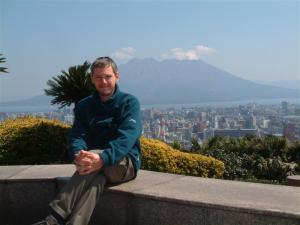
Unencumbered by luggage, I was able to people-watch as I returned by train to my hotel. In Tokyo (and indeed all over Japan) people of all ages wear white facemasks to prevent others from catching their cold – very thoughtful. The Japanese must work very hard as most of the commuters that I sat next to on trains were always asleep. One man that I saw sleeping was leaning forward and almost fell off his seat (like Mr Bean!) before waking up with a jolt. And for such a huge place Tokyo is astonishingly safe. It’s absolutely normal for very young schoolchildren to travel by themselves on trains and buses. Japanese children often look much older than they really are, though. Uniformed schoolgirls who I suppose were in their teens (i.e. 15/16) frequently looked as though they were19/20. Indeed, there is a very unhealthy fetish amongst Japanese men for teenage girls, and a great deal of Japanese pornography features attractive young ladies dressed up in school uniforms. Not that I’ve looked at any porn mags, of course, but it is quite normal in Japan for men to read porn on trains and in newsagents. Actually, I might have glanced at one whilst waiting for a train – purely in the interests of research, naturally. If Japanese men aren’t looking at porn whilst waiting for a train or bus then they will inevitably be practising their golf swing. The announcement jingles in stations and on trains are also hugely enjoyable, ranging from short, cheery tunes to long and melancholic pieces that I’m sure influence commuters’ moods.
I had only four nights in Tokyo (with another three booked at the end of my stay in Japan) and I wanted to see rather more of central Honshū (Japan’s main island) than just Tokyo itself. My first out of town trip was to Nikkō, 80 miles north of the capital. This was also my first opportunity to travel on a Shinkansen, the famous Bullet Train that is so symbolic of Japan. I have enjoyed the outstanding TGV in France, the DB Intercity in Germany, and the Alta Velocidad in Spain but theShinkansen is truly magnificent. The conductor even bows as he or she leaves and enters a carriage. (I will definitely write to Richard Branson suggesting that he implements this on his dismal Virgin trains). They are punctual, immaculately clean (the trains are often cleaned prior to departure from a station), very comfortable, and – above all – fast. The acceleration of a Shinkansen as it departs from a station is incredible. These trains have up to 15 or 16 carriages but by the time the last car has gone past the end of the platform the train must be travelling at close to 50mph. On another train that I travelled on there was a speedometer in the dining car that registered 250 km/h (150mph). And that was one of the older trains, with the classic “bullet nose.” The newer trains are even faster. The speed of the trains also gives an indication of the size of Tokyo’s sprawl. On my train heading north to Nikkō it was half an hour before any greenbelt land could be seen. The train was going flat out too, probably in excess of 150mph. This suggests that the Tokyo suburbs stretch about 75 miles north of the city centre.
Nikkō, however, was worth the trip. It’s a beautiful little town, with a World Heritage listed shrine complex set amid woodland and hills. The gentle sprinkling of snow that fell during my visit made it an even more romantic place. The serenity of the shrines and temples was an almost surreal contrast to the energy of Tokyo, just an hour away. My other day-trip from the city was to Kamakura, a small town with an extraordinary 65 temples and 19 shrines. The most splendid sight here is theDaibutsu (Great Buddha), a 750 years old, 11 metres tall bronze statue of the Buddha Amida Nyorai that has stood outdoors in a woodland setting for over 500 years. On the way back to Tokyo I visited Yokohama, Japan’s second city, with a population of about 10 million. I enjoyed a stroll through the very lively Chinatown and then a walk along the harbour front, where a crowd had gathered to watch a street magician perform. He played an absolutely wonderful gag on a young boy that had everybody laughing aloud. The magician put his hand inside the boy’s pocket and pulled out what at first looked like a handkerchief but was actually a pair of underpants. The poor boy then peered inside his trousers to check that he still had his underwear.
After four nights in Tokyo, it was time to hit the road. I originally planned to stop in Nagoya but instead pushed on to Kyoto, where I spent three very pleasant nights at the Budget Inn youth hostel. I dropped off my bags when I arrived and went off to explore Kyoto for the day. When I returned my bags had disappeared. “Where’s my luggage?” I growled at the friendly Japanese at reception. “I’ve put them upstairs in your room, and made your bed also,” he replied sheepishly. I explained to him that I wasn’t really used to such impeccable service in youth hostels and had instead assumed that my bags had been stolen. My hosts’ English was largely fluent, but they didn’t quite translate everything accurately. In the Japanese style living room, complete with tatami floor and shōji screens, there was a spoon specifically for stirring coffee – a “mixed up spoon” in fact. And if you weren’t acclimatising well to the Japanese way of life, “Those who don’t like to observe the above rules will be rejected to use the facilities.” On a Shinkansen train there is a choice between a “Japanese style” and a “Western style” toilet. For those unused to a “Western style” loo, there are written and pictorial instructions. No translation needed.
Despite the intensely cold weather during my stay, Kyoto is undoubtedly the most pleasant city in Japan. Although it has suffered in the name of modernisation like virtually every other Japanese city, it emerged unscathed from World War II, a remarkable escape considering that it was on the list of potential targets for the Atom Bomb. The city centre is largely modern and sterile, but the Gion district to the east is quite lovely, with traditional wooden houses and cobbled lanes set against woodland covered hills dotted with temples. The 740-year-old Sanjūsangen-dō temple hall contains 1001 gilded statues that protect the Buddhist Goddess of Mercy Kannon. At first glance they all appear to be identical but each statue has subtle differences in its face, clothes or jewellery. It is a truly awe-inspiring spectacle to see these 1001 golden statues lined up inside the 123 metre long hall. The 67 tonne Daishō-rō bell – Japan’s largest – inside the Chion-in temple complex is also an impressive sight. It requires 17 priests to ring the bell on New Year’s Eve. Gion is also home to the majority of Japan’s enigmatic geisha. I was intending to stroll around Gion one evening to try and spot one of these elusive creatures but I’m afraid that the cold weather defeated me.
From my base in Kyoto, I was able to visit some other places in this part of Japan. Ōsaka is Japan’s third largest city and yet another ugly metropolis, but an immensely wealthy one at that: the Gross Domestic Product of Ōsaka exceeds that of Australia. The castle Ōsaka-Jō somehow survived the heavy bombing inflicted upon the city during the War, although it had already fallen into disrepair over the years after the Meiji Restoration and was rebuilt of concrete in 1931, and again in 1948. It now has an elevator inside its main tower. The castle walls are very impressive, however, with a single 130 tonne rock in the wall at the Sakura-mon gate. And the blossoming plum trees in the castle grounds were a wonderful sight, with hordes of tourists – yes, they get Japanese tourists here too – taking photographs. I also saw the Kirin Plaza, featured in Ridley Scott’s film Black Rain. I’m sure that Scott was also influenced by night-time Tokyo for the mise-en-scène of Blade Runner. I have wandered around Shinjuku in the evening and seen the giant TV screens and neon signs fizzing in the darkness, and that is exactly how he has represented 2019 Los Angeles in his film.
I visited Kōbe briefly, which has recovered from the 1995 earthquake in a remarkably short space of time, and also went to Nara, home to another huge 15 metre tall Buddha statue, parts of which are an extraordinary 1300 years old. Unlike the Kamakura Daibutsu, the statue here is housed inside an immense hall that is still the world’s largest wooden building. The temple is surrounded by a park filled with tame deer that are relentless in their pursuit of food from well-fed tourists. I escaped harassment from the deer but was ambushed instead by a group of schoolchildren who insisted on practising their English and then having their photograph taken with me. Somewhere in Japan is a picture of a rather bemused Englishman in his beloved Aston Villa hat, surrounded by students doing the typically Japanese “V” sign. I was ambushed again on the train back to Kyoto, this time by a gentleman who told me that he was 70. He had an excellent command of English.
From Kyoto I continued west to Hiroshima. Although I was enjoying my travels around Japan, I was starting to feel homesick for the first time on my trip. It was cold, it was wet, it was expensive (there is a 5% consumption tax on virtually all goods and services), and I missed my friends in New Zealand. The freezing corridors at the YHA were the final straw. I felt rotten and booked three more nights in Tokyo (giving me a total of six nights) so that once I had seen Hiroshima and Nagasaki I could return there and not have to worry about finding somewhere to stay out on the road.
Then I met the lovely Mariko Ban. She is the chef at Hiroshima YHA and the sole reason why I ended up staying rather longer in Hiroshima than I intended. I liked her food, and I liked her. The ladies at the YHA reception (who all spoke excellent English, particularly Mariko) were intrigued when I wrote “wine writer” in the “occupation” column of the guest card and I found myself being treated to some Japanese wine. We drank a red wine made from the concorde variety, with its distinctive and not very pleasant “foxy” Vitis Labrusca smell. And it was definitely sweet, too. The girls bought a bottle of Rioja for my second night, a 1999 crianza, which was corked and too old to show well. The wines were rather disappointing but the food conjured up by Mariko and Rumiko was always good. I ate very well in Japan (and was frequently complimented on my chopstick technique), with lots of rice, noodles, tempura, vegetables, sushi, eggs, and the domestic beers aren’t bad, either. Kirin and Sapporo are infinitely preferable to Victoria Bitter, in my opinion. The girls also told me that cincin – the Italian version of “cheers” – means ‘penis’ in Japanese. I enjoyed toasting their health with each glass I drank: “CINCIN!”
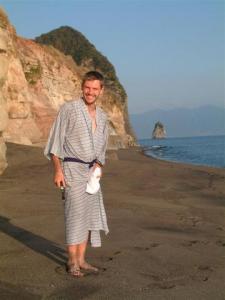
Hiroshima itself was certainly one of the more pleasant cities that I visited, with two rivers and plenty of parks. I went to the Peace Memorial Museum – the whole purpose of my visit to Hiroshima – and was shocked by some of the exhibits there. There were charred roof tiles, misshapen wine bottles, scorched clothing and many other things that gave some impression of the immense damage caused by the A-Bomb. The most shocking item that I saw was a step that was originally outside a bank, only a few hundred metres from the epicentre of the blast. The heat was so intense that an anonymous person sat waiting for the bank to open was instantly vaporised and his/her shadow seared onto the concrete. There are also many photographs that I hadn’t seen before of the appalling injuries suffered by many people, and many stories from individuals that survived, like the man who was leaning out of his window when the bomb exploded and had the ends of his fingers burned off. When I went to the A-Bomb Dome – the famous dome that was left standing after the blast – it was snowing again, lending the scene even more pathos.
Continuing the A-Bomb theme, I also travelled to Nagasaki. The city has a Catholic cathedral; as the first Japanese port to be opened to Western traders, Nagasaki became a centre of Christianity. (I seem to recall also seeing a Russian Orthodox cathedral in Tokyo). The cathedral is a replica of the original that was destroyed by the bomb. Outside the front porch there are a few statues preserved from the blast, and it is easy to see the damage caused by the heat of the bomb on these, the stone surface having bubbled and ruptured.
The island of Miyajima is an easy day-trip from Hiroshima. The 16 metre tall Ō-Torii (Grand Gate), almost as famous a symbol of Japan as Fuji, is a beautiful sight, standing 200 metres out to sea from the equally lovely Itsukushima shrine. I managed to get about halfway up Mount Misen to Momijidani Park. It snowed. My final day-trip from Hiroshima was to Himeji, one of Japan’s few surviving feudal-era fortresses and the backdrop to the Bond-San film You Only Live Twice. Originally built in 1581, the castle survived the war because of its use as a reference point by US bombers: turn right for Ōsaka, left for Hiroshima. Sadly I didn’t get to meet Bond’s ladyfriend Kissy Suzuki, but whilst I was in Himeji I rang a friend whom I had first met on my European travels two years previously. Wayne d’Eon is an affable Canadian who has lived in Japan for 11 years and we had corresponded about my visit before my arrival in the country. I finally spoke to him that day and he very kindly offered me a bed for a couple of nights at his place in Kagoshima, at the southern tip of Japan. Because of the distances involved I had no intention of going to Kagoshima until I found out that Wayne lived there.
The six-hour train journey from Hiroshima to Kagoshima turned out to be a pleasant surprise. Shinkansen trains only run as far as Fukuoka, so I had to take a local train for the rest of journey to Kagoshima. (Shinkansen trains are due to start running from Kagoshima later this year, reducing a four-hour journey to about two hours). Kyūshū has a splendid coastline, however, that made this long journey a real pleasure. I went through a very peculiar resort town called Huis ten Bosch (sic), a meticulously built replica of a Dutch port, including a perfect recreation of the Dutch royal palace. Eventually I arrived at Kagoshima where I was met by Wayne (who has been on a shinkansen only once in 11 years in Japan, so expensive are these trains – but I had a rail pass) and taken to his shoebox apartment. I was staggered at how small his flat was (which he shares with his extremely nice wife Yukiko), and even more appalled when he told me that it was not uncommon for families with two or three (or more) children to live in an apartment of this size. I was much happier though when I saw his toilet. One of the true joys of Japanese life is the heated toilet seat and a device that plays the sound of flushing water to disguise embarrassing noises. Wayne’s loo had what looked like a television remote control attached to it, which I dared not touch for fear of something squirting water at me – or even worse. His loo has got more buttons on it than my hi-fi system.
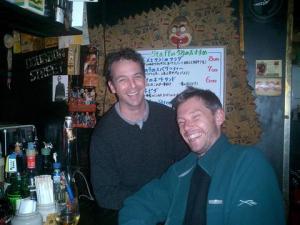
This being deepest Japan, poor Yukiko was left at home whilst Wayne and I went off to enjoy Kagoshima’s bars. Drinking is a very expensive hobby in Japan, as most places have a cover charge before you have even ordered a glass of beer. Kagoshima is not a small city by British standards – it has a population of about half a million – but in Japan it’s considered a remote, sleepy place. Wayne still has to carry hisgaijin card (foreign resident’s card) because, as the Japanese insist, gaijin waabunai yo – “foreigners are dangerous.” Even I noticed how conspicuous gaijin are in Japan. My eyes would sometimes catch those of another foreigner and there would usually be a nod or smile to acknowledge each other. I was also amazed at how many “hostesses” there were roaming the city centre, most of them employed at what the Japanese call “snack bars,” drinking holes where “salary men” (suit wearing office workers) can recover from karōshi (death by overwork) and get plastered in the company of a “hostess” for ¥4000 an hour, with as much shōchūand whisky as they can drink. Beer costs extra. There is surely something for everyone in Japan: soaplands, fashion health soaplands, fashion health clubs, pink salons, massage parlours… As Wayne told me, “The sex industry in Japan is HUGE.”
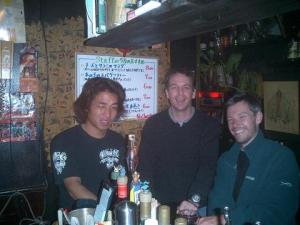
The following day Wayne took me for a drive around his part of Kyūshū to a soundtrack of Chet Baker. “My Buddy” was just the right song for us. Our first stop was at an art gallery up in the hills behind the city, from where there is a splendid view of the still active volcano Sakurajima (Cherry Blossom Island) that so dominates the bay. One million people lie within a six-mile radius of the volcano. Kagoshima and Sakurajima bear a striking resemblance to Naples and Vesuvius; indeed, Kagoshima is known as “the Naples of Japan,” but I doubt whether the people of Kagoshima speak a dialect as impenetrable as Neapolitan. From there we continued on to the lovely samurai houses and ornate gardens at Chiran, where there is also the Peace Museum for Kamikaze pilots. I felt very uneasy walking around here. Some of the pilots were just 17 years old when they were asked to make the ultimate sacrifice and it is hard to be unmoved by the photographs of these men whose young lives were so wasted. And yet I was troubled by how these men – boys? – had been turned into heroes for wasting their own lives in order to kill as many other people as possible. The kamikaze prevented an invasion, but this led instead to the A-Bomb.
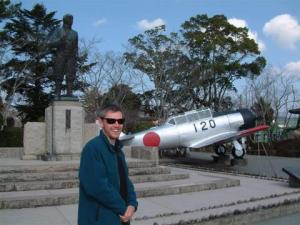
Our final stop of the day was rather more cheerful. Ibusuki has a stretch of thermal sands where you may take a sand bath. For ¥900 you can change into a yukata and have yourself buried in the hot sand. The temperature is extremely hot – over 50ºC – and it was absolutely excruciating before I was rescued by having some cooler sand shovelled underneath me. Then it was just perfect, and wonderfully relaxing. Highly recommended.
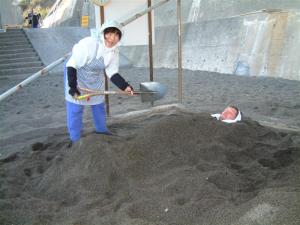
After that hugely enjoyable stay with Wayne and Yukiko (which thoroughly cured me of homesickness) I undertook the long journey back to Hiroshima and my friend Mariko, armed with a couple of bottles that I had bought in quite a nice wine shop in Kagoshima. I even found some Cullen, Plantagenet and Pegasus Bay wines here. I treated Mariko and Rumiko to a half bottle of 1999 Olivier Leflaive Bourgogne chardonnay and a half bottle of 2001 Joseph Drouhin Bourgogne rouge. The chardonnay was corked and a bit oxidised but the pinot noir was pleasant enough. Having had a couple of corked bottles that were also distinctly over the hill, I think that Japanese wine merchants have yet to master the art of storing wine correctly.
I was due back in Tokyo after one more night in Hiroshima. Mariko saw me off at the bus stop, but not before she had given me some sandwiches for my lunch and asked “Wouldn’t you prefer to stay here for the rest of the week?” When you have a pretty girl giving you lunch and asking if you would like to stay with her, it is agonyto have to leave. Of course I wanted to stay but all of my accommodation in Tokyo was paid for and I couldn’t get a refund on any of it. I had already missed one night in Tokyo in order to return to Hiroshima and that had cost me a small fortune. As much as I liked Mariko, she was an expensive fling. “I Fall in Love Too Easily”… Chet Baker again.
Once I was established back in Tokyo, I decided to have some more day-trips from the city. I was determined to see Mount Fuji and set off from the city on a bright and crisp morning. By the time I had arrived at Ōtsuki it was pouring with rain. I soldiered on to Fuji-Yoshida regardless, confident that I would finally see Fuji-san. After a two-hour train ride from Tokyo I finally arrived at Fuji-Yoshida and stepped off the train. I looked in every direction. Fuji-san was nowhere to be seen. The weather was so appalling that the surrounding mountains, including Fuji, were completely obscured by rain and mist. I trudged back to the train and braced myself for the long ride back to Tokyo. I was not happy.
I headed north the next day to Morioka, the furthest north that I was able to reach in one day. Honshū is far less populated here, a pleasant contrast to the almost continuous urban strip that runs west from Tokyo to Kyoto and beyond. Morioka itself is uninteresting but it is surrounded by sublime mountain scenery. On the return journey to Tokyo I stopped at Matsushima, as lovely a place as any that I have seen in Japan. Although I only had time for a quick look around the town itself, Matsushima Bay has 260 islands of every shape and size, a really wonderful sight. I decided to have another crack at Fuji and this time I was more fortunate with the weather. On a beautiful, sunny Sunday morning I walked through Fuji-Yoshida to get within 17km of the summit of Fuji-san, 3,776m high. It’s a truly beautiful work of nature, with its perfect symmetry and snow-crowned summit. I’m glad that I persevered and returned.
Those two excursions left me with three days in Tokyo itself, enabling me to have a thorough nose around the world’s largest city. In Asakusa, about three miles north of the Imperial Palace, there is the vast Sensō-ji temple, an utterly incongruous sight in this vast metropolis. Ginza, to the east of the Imperial palace, is Tokyo’s most exclusive shopping area, and where I found my mother’s requested fan and a bottle ofshōchū for myself. I wandered into the Sony Building here, which has every new gadget imaginable, and ate my lunch inside the magnificent Tokyo International Forum, 60 metres high and with a ceiling ribbed like a ship’s hull. I enjoyed browsing in Tokyo’s music shops, which have absolutely the best guitars that you can buy – Martin, Fender and Gibson – not like the cheap rubbish I saw in Australia and New Zealand. Something to do with the size of the economy, I reckon. I had an early morning stroll through the Tokyo Central Wholesale Market in Tsukiji before a train ride over the 918 metre long Rainbow Bridge (nothing to do with Jimi Hendrix, apparently) to the hideous man-made beach at Odaiba. I’ve been to the Tokyo Dome and the National Sumo Stadium, too. My favourite Tokyo landmark, however, is the Tokyo Metropolitan Government Building in Nishi-Shinjuku. This colossal structure houses 13, 000 bureaucrats but they have very thoughtfully opened a free observation room on the 45th floor, 202 metres high. I spent my final night in Japan here, looking down at the multi-coloured lights and neon of Shinjuku spark into life.
That, then, is Japan in a Dishpan. What at times was a very hard slog, with cold weather, incomprehensible station exit signs, high accommodation costs and homesickness plaguing me, eventually became a triumphant and hugely enjoyable adventure. Travel in the purest sense, indeed, and a vindication of my decision to visit Japan.
These were my initial, formative experiences of modern, paradoxical Japan: a country that has been relentlessly urbanised and industrialised with a tremendous cost to the environment, and yet also a nation that has reminders of – and almost a longing for – a much gentler and more beautiful way of life, hidden away from the concrete and the factories. I have visited several paradoxical, complex nations – Italy and South Africa, for instance, come to mind – but none is quite so enigmatic as Japan. In her splendid book Geisha: The Secret History of a Vanishing World, Lesley Downer quotes Oscar Wilde: “In fact, the whole of Japan is a pure invention. The Japanese people are simply a mode of style, an exquisite fancy of art.” Wilde was referring to the nineteenth century fashion for Japonisme, but his comment still has remarkable contemporaneity.
I have been to a centuries old castle that has an elevator inside its main tower, and I have seen middle-aged Japanese women dressed in a kimono chattering into a mobile phone whilst running to catch a Bullet Train. This is a country where men openly read pornography on public transport and pee in the streets, but also a country where department store assistants bow to you as you walk past their counter. A country that has identikit cities, all with their neon signs and giant TV screens, but has a sublime, scarcely populated natural landscape. A nation of workaholic “salary men” who are unfettered sybarites in their precious leisure time. A country that was occupied by foreign forces just fifty years ago, and opened itself to outside influences only 150 years ago. Which is the true Land of the Rising Sun? The urbanised, technology obsessed, Bullet Train, baseball mad Japan, or the land of ancient Buddhist temples, Zen philosophy, kimono, geisha and an Emperor who traces back his ancestry to 660 BC? Is Japan an ancient society that is under siege from modernity, or a modern nation tinged with anachronisms? Japan teeters between Western modernisation and Asian tradition, but does it teeter gloriously or precariously? Perhaps it doesn’t teeter at all, and Japan really is defined by this strange amalgamation of old and new, East and West.
One of my favorite blogs about a gaijin traveling in Japan… I’m also a gaijin, not from the west but here from asia. I have have not yet done everything that you experienced in my 2 years here. I arrived in 1 city and stayed in the same city. Anyway, I really love it and hope someday i would meet my own Mariko…
As a former ex-pat that lived in Japan for several years back in the ’80s, I enjoyed reading about your trip greatly. However, you blog doesn’t say what period you traveled there… and it is difficult to tell, from the photos…
some of the photos (e.g., from the bar(s) ), appear to be older…. and remind me of places from 20 years ago…
I would request that you date your blog, to assist those of us who would be interested in the time frame of your travel(s)…
Best wishes and look forward to many more of your wonderful and informative stories!